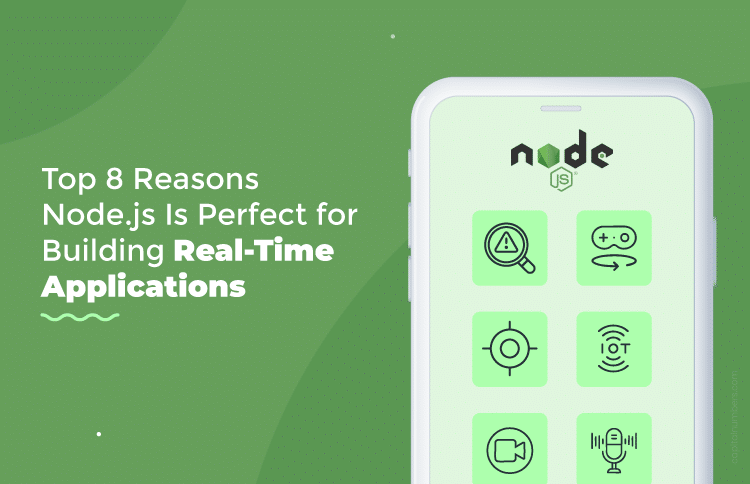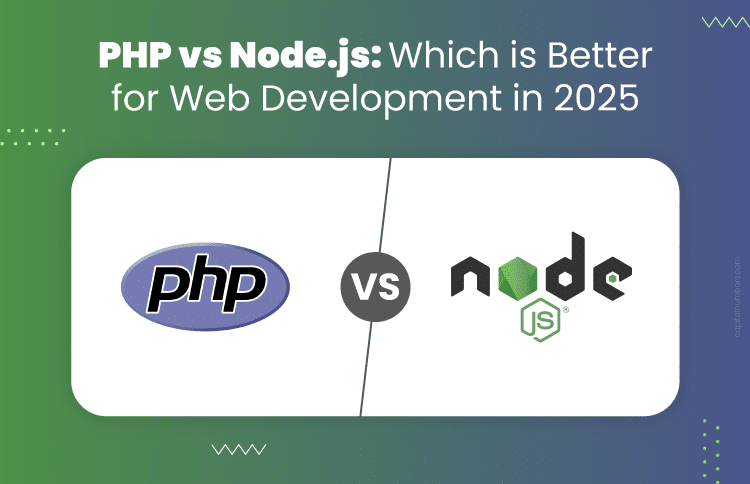Top 8 Reasons Node.js Is Perfect for Building Real-Time Applications
Table of Contents
Web apps are getting smarter, and so are user expectations. They want instant updates, smooth interactions, and no waiting around. Whether it’s live chat, team collaboration, or online gaming, real-time functionality isn’t just nice to have—it’s what makes the experience truly seamless.
But what’s the best technology to power these real-time experiences? Enter Node.js—a fast, scalable, and event-driven runtime that’s perfect for handling real-time interactions. In this blog, we’ll highlight 8 key reasons why Node.js is the ideal choice for building real-time applications. Whether you’re a developer or managing a tech team, these insights will help you understand how Node.js enables scalability, high performance, and real-time responsiveness.
Why Node.js is the Perfect Fit for Real-Time Applications
Node.js is built on an event-driven, non-blocking architecture, allowing it to efficiently handle multiple simultaneous connections. Its built-in WebSocket support and data streaming capabilities enable real-time updates without delays, making it perfect for messaging apps, online gaming, collaborative platforms, and live dashboards. Additionally, its lightweight and scalable nature ensures high performance even under heavy traffic.
Now, let’s explore the top 8 reasons why Node.js excels in real-time application development.
1. Event-Driven & Non-Blocking I/O: The Power Behind Node.js for Real-Time Apps
Node.js is designed to handle multiple tasks at the same time, making it extremely efficient for real-time applications. This is possible because of two key features: event-driven architecture and non-blocking I/O operations. Let’s break them down:
What is Event-Driven Architecture?
Event-Driven Architecture (EDA) is a software design pattern where system components communicate by producing and consuming events. Instead of relying on direct calls between services, applications react to events as they occur, making them highly scalable, responsive, and efficient.
How It Works
At its core, event-driven architecture consists of three main components:
- Event Producers – These generate events when something happens (e.g., a user submits a form, a payment is made, or a sensor detects motion).
- Event Brokers – These act as a middle layer, distributing events to the appropriate consumers.
- Event Consumers – These receive events and trigger actions (e.g., sending a notification, updating a database, or processing an order).
What is Non-Blocking I/O?
Traditional web servers handle tasks in a blocking way, meaning if a request takes time (e.g., fetching data from a database), everything else must wait until it’s done. Node.js, on the other hand, follows a non-blocking I/O model, which means it can start multiple tasks at the same time without pausing.
For example, if a user sends a message in a chat app, Node.js can handle it instantly while also processing live notifications, file uploads, or API requests—all without slowing down.
Why is This Important for Real-Time Applications?
Since real-time applications require handling thousands (or even millions) of simultaneous connections, Node.js makes them fast and responsive. With event-driven programming and non-blocking I/O, Node.js can efficiently manage multiple requests, ensuring real-time data updates without delays or bottlenecks.
Looking to Build a High-Performance Real-Time Application? Hire expert Node.js developers from Capital Numbers to create scalable, real-time solutions with seamless performance and instant data updates.
2. WebSockets for Two-Way Communication: Keeping Client and Server in Sync
For real-time applications, the client (user’s device) and the server need to exchange data continuously. Traditional web applications rely on HTTP requests, where the client sends a request and waits for the server to respond. But for real-time applications, this approach is too slow and inefficient.
What Makes WebSockets Different?
WebSockets allow two-way (bidirectional) communication between the client and server over a single, always-open connection. Instead of the client continuously asking, “Is there any new data?” (which happens in traditional HTTP polling), WebSockets let the server push updates to the client instantly as soon as something changes.
How Do WebSockets Work in Node.js?
- When a user opens a web app (e.g., a chat application), a WebSocket connection is established between the client and the server.
- This connection remains open instead of closing after each request, like in HTTP.
- Both the client and server can send messages to each other at any time, making it perfect for real-time interactions.
- Since the same connection is reused, it reduces network overhead and improves efficiency.
Why is This Important for Real-Time Applications?
- Instant Updates – Messages, notifications, or game scores are updated in real time without delays.
- Less Network Load – Since WebSockets keep a persistent connection, there’s no need for repeated HTTP requests, reducing server strain.
- Better User Experience – The connection feels seamless, and users see real-time changes without needing to refresh the page.
3. High Scalability: Handling Thousands of Users Without Slowing Down
When building real-time applications, handling a growing number of users efficiently is crucial. If too many users connect at the same time, a traditional server setup might slow down or even crash. This is where Node.js shines—its lightweight and asynchronous architecture makes scaling much easier.
How Does Node.js Handle Scalability?
Unlike traditional web servers that create a separate thread for each user request (which consumes a lot of memory), Node.js runs on a single-threaded, event-driven architecture. This means:
- Handles Many Connections at Once – Instead of blocking and waiting for one request to finish before moving on to the next, Node.js efficiently manages multiple connections in parallel.
- Uses Non-Blocking I/O – It doesn’t waste time waiting for database queries, API calls, or file operations. It simply moves on to the next task and returns to the previous one once it’s ready.
- Lightweight and Fast – Because Node.js doesn’t create new threads for every connection, it consumes much less memory and CPU, allowing it to handle thousands of simultaneous users smoothly.
Why is Scalability Important for Real-Time Apps?
Real-time applications must process updates instantly and serve multiple users at once. Here’s how Node.js makes scalability effortless:
- Live Dashboards – Imagine a financial dashboard tracking stock prices for thousands of users. Node.js updates data instantly without delays.
- Collaborative Tools – Apps like Google Docs or Trello allow multiple users to work together in real time. Node.js ensures everyone sees updates simultaneously without lag.
- Social Media Feeds – Twitter, Facebook, and LinkedIn push live notifications and status updates to millions of users. Node.js efficiently delivers updates in real time without overloading servers.
Scaling Even Further: How to Make Node.js Applications Even More Scalable?
- Load Balancing – Distribute incoming traffic across multiple Node.js instances using NGINX or PM2, so no single server gets overloaded.
- Microservices Architecture – Instead of having one big application, break it into smaller services that handle specific tasks. This improves scalability and maintainability.
- Horizontal Scaling – If traffic increases, add more servers (instances) to share the load instead of upgrading a single machine.
- Using Redis for Real-Time Data – Redis, a fast in-memory database, can store and retrieve real-time data lightning fast, reducing database bottlenecks.
4. Fast Execution with V8 Engine: Why Node.js is Super Fast
One of the biggest reasons Node.js is so fast is because it runs on Google’s V8 JavaScript engine—the same engine that powers Google Chrome. But what makes V8 special, and why is it so important for real-time applications? Let’s break it down.
What is the V8 Engine?
The V8 engine is an open-source JavaScript engine developed by Google. It takes JavaScript code and compiles it directly into machine code, which the computer can process much faster than traditional interpreted code.
In simple terms:
- Traditional JavaScript Execution – Code is read line by line and interpreted, which can be slow.
- V8 Execution – JavaScript is compiled into machine code before execution, making it run much faster.
How V8 Makes Node.js Faster?
- Just-In-Time (JIT) Compilation – V8 converts JavaScript into machine code on the fly, improving execution speed significantly.
- Garbage Collection – The engine automatically clears up unused memory, preventing slowdowns caused by memory leaks.
- Optimized Performance – With V8, JavaScript code runs as fast as compiled languages like C++ in many cases.
5. Single-Threaded with Asynchronous Processing: How Node.js Handles Thousands of Requests Efficiently
When building web applications, handling multiple users at the same time is crucial. Traditional web servers use multi-threaded architectures, where each request gets its own thread. While this works, it can become inefficient and slow when dealing with thousands of users.
Node.js takes a different approach. It runs on a single-threaded event loop with asynchronous processing, making it lightweight, efficient, and perfect for real-time applications.
What Does “Single-Threaded” Mean?
In traditional multi-threaded systems:
- Each incoming request gets a separate thread.
- If too many users connect, the system uses too much memory and slows down.
- Managing multiple threads can be complex and cause performance bottlenecks.
In Node.js, instead of creating a new thread for every request, it runs on a single thread that handles multiple requests using an event loop.
What is the Event Loop and How Does It Work?
Think of a restaurant with one chef. Instead of cooking one meal at a time, the chef starts multiple dishes, lets ingredients cook, and moves on to the next order while waiting. Similarly, Node.js doesn’t wait for one request to finish before moving to the next. It processes multiple tasks asynchronously.
Here’s what happens:
- A user sends a request to the server.
- The event loop picks up the request and checks if it requires external work (like fetching data from a database).
- If it does, Node.js doesn’t wait—it moves on to the next request while the database query runs in the background.
- Once the database responds, Node.js picks up where it left off and returns the result to the user.
This approach prevents delays and ensures the application runs fast and smoothly even with thousands of users.
6. Easy Implementation of Real-Time Features: Build Faster with Node.js & Socket.io
Building real-time applications might sound complex, but Node.js makes it surprisingly easy, thanks to powerful libraries like Socket.io. Whether you’re adding instant messaging, live notifications, real-time tracking, or online collaboration, Node.js provides tools that help you implement these features with minimal effort.
How Does Socket.io Make Real-Time Development Easy?
Socket.io is a popular WebSocket library for Node.js that enables real-time, two-way communication between the client and the server. Here’s why it’s so useful:
- Built-In Event Listeners & Emitters – Instead of writing complex code for handling messages, Socket.io provides predefined events like connect, message, and disconnect. You just define what happens when these events occur.
- Automatic Connection Handling – Socket.io automatically manages WebSocket connections, reconnecting users if they lose connection and fall back to HTTP polling if needed.
- Broadcasting Capabilities – You can send messages to all connected users (e.g., live notifications) or specific groups (e.g., chat rooms).
- Cross-Platform Support – Works on web browsers, mobile apps, and desktop applications.
With Node.js and Socket.io, implementing real-time features is no longer a challenge—it’s an opportunity to enhance user engagement with minimal complexity. Whether you’re building live chat apps, real-time notifications, collaborative tools, or live tracking systems, these technologies provide a fast, scalable, and efficient way to deliver seamless real-time interactions.
7. Microservices and API Support: Building Scalable Real-Time Applications with Node.js
When developing large applications, it’s often better to break them into smaller, independent services instead of having one big, complicated system. This is called a microservices architecture, and Node.js is a great choice for it.
Node.js allows developers to build real-time APIs that can handle different services separately while still working together smoothly. It also integrates well with real-time databases like MongoDB, Redis, and Firebase, making data storage and retrieval fast and efficient.
What is a Microservices Architecture?
Instead of building one large, complex application, microservices break it down into smaller, self-contained services that communicate with each other.
- Traditional Monolithic Architecture – Everything (user authentication, payments, notifications, etc.) is handled in a single application. If one part fails, the whole app might stop working.
- Microservices Architecture – Each function (e.g., authentication, payments, notifications) runs as a separate service. These services work independently and communicate using APIs.
Why is Node.js Perfect for Microservices?
- Lightweight & Fast – Node.js runs on a single thread and handles multiple requests asynchronously, making it perfect for microservices that need to respond quickly.
- Scalability – Each microservice can scale independently, meaning you can add more servers for high-traffic services (like live chat) without affecting the rest of the system.
- REST & GraphQL API Support – Node.js makes it easy to build APIs using Express.js for REST APIs or Apollo Server for GraphQL APIs, allowing microservices to communicate efficiently.
- Real-Time API Support – Node.js, combined with WebSockets and Socket.io, allows APIs to provide instant updates instead of waiting for clients to request data.
You May Also Read: Unleashing the Power of Node.js: The Ultimate Platform for Microservices Integration
How Node.js Works with Real-Time Databases
Node.js seamlessly integrates with databases optimized for real-time performance:
- MongoDB – A NoSQL database that stores data in a flexible format, ideal for handling large amounts of real-time data. Works great with Mongoose ORM in Node.js.
- Redis – An in-memory database that stores frequently accessed data, making it super fast for chat apps, live notifications, and real-time leaderboards.
- Firebase – A cloud-based database by Google that provides real-time data synchronization, making it easy to build apps that update across all users instantly.
With Node.js and microservices, you can build highly scalable and efficient real-time applications. By integrating with real-time databases like MongoDB, Redis, and Firebase, Node.js ensures fast data processing and instant updates, making it ideal for real-time chat apps, collaboration tools, and live dashboards.
You May Also Read: MongoDB and Node.js: How Are They Changing the Future of App Development?
8. Efficient Handling of Large Data Streams: Why Node.js is Ideal for Streaming Applications
Some applications need to handle huge amounts of data in real time. Instead of waiting for all the data to be received before processing it, Node.js can process data in small chunks as it arrives, making it much faster and more efficient.
This is possible because Node.js supports data streaming, allowing applications to handle large data flows without consuming too much memory.
What is Data Streaming?
In traditional applications, when a large file (like a video or stock market data) needs to be processed, the system waits for the entire file to download before starting to use it. This approach is slow and inefficient.
With Node.js streaming, data is processed in small pieces (chunks) as it arrives, so the application doesn’t have to wait for the entire file to load before starting to use it.
Think of it like watching a YouTube video:
- Without streaming – You have to wait for the entire video to download before you can watch it.
- With streaming – The video starts playing immediately, while the rest of the file is still loading in the background.
How Does Node.js Handle Large Data Streams?
Node.js provides built-in stream modules that allow developers to handle continuous data processing efficiently. These streams work in four different modes:
- Readable Streams – Data is received chunk by chunk (e.g., reading a large file from a server).
- Writable Streams – Data is sent chunk by chunk (e.g., sending a video file to a user).
- Duplex Streams – Can read and write data at the same time (e.g., a real-time chat app).
- Transform Streams – Modify or process data as it moves through (e.g., compressing a file before saving it).
Why is Node.js Perfect for Streaming Applications?
- Low Memory Usage – Since data is processed in chunks, Node.js doesn’t need to load large files into memory, preventing crashes.
- Faster Data Processing – Streaming reduces delays, making real-time applications run smoothly.
- Handles High User Traffic – Streaming is useful for apps where thousands of users access data at the same time (e.g., Netflix, Spotify, stock market apps).
With built-in support for streaming, Node.js is an excellent choice for applications that handle large, continuous data flows. Whether you’re building a live streaming platform, a multiplayer game, or a financial market app, Node.js ensures efficient, real-time data processing without performance bottlenecks.
You May Also Read: Optimizing Node.js Performance: A Comprehensive Guide to Building Faster Applications
Conclusion: Why Node.js is the Best Choice for Real-Time Applications
When building real-time applications, speed, scalability, and efficiency are critical. Node.js excels at handling large volumes of users and processing real-time data seamlessly, making it a top choice for applications like live chat, online gaming, real-time notifications, and financial dashboards.
With non-blocking I/O and WebSocket support, Node.js enables instant data transmission, ensuring smooth, responsive interactions without delays. Whether it’s live messaging, collaborative tools, or real-time analytics, Node.js keeps users engaged with instant updates and seamless performance.
If your application demands high concurrency, low latency, and real-time responsiveness, Node.js provides the perfect foundation. Its event-driven architecture and efficient data handling make it an ideal solution for modern real-time applications.















